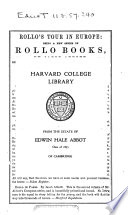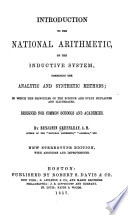 | Roswell Chamberlain Smith - Arithmetic - 1856 - 334 pages
...12. 31. Hence, when the extremes and common difference are given, to find the number of terms : — Divide the difference of the extremes by the common difference, and the quotient, increased by 1, will be the answer. 32. If the extremes be 3 and 45, and the common difference 6. what... | |
 | Charles Guilford Burnham - Arithmetic - 1857 - 328 pages
...Therefore — Art, 289. — When the first and last terms, and the common difference* are given, to find the number of terms — RULE. Divide the difference...extremes by the common difference, and the quotient will be 1 less than the number of terms. 10. If the first term of a series be 2, and the last term... | |
 | Charles Guilford Burnham - 1857 - 342 pages
...Therefore — Arti 239«— When the first and last terms, and the common difference are given, to find the number of terms — RULE. Divide the difference...extremes by the common difference, and the quotient will be 1 less than the number of terms. 10. If the first term of a series be 2, and the last term... | |
 | James Stewart Eaton - Arithmetic - 1857 - 376 pages
...of terms less one. Hence, 34:8. PROB. 3. — The extremes and common difference being given to find the number of terms, RULE. — Divide the difference of the extremes by the common difference, add 1 to the quotient and the sum will be the number of terms. Ex. 1. The extremes of an arithmetical... | |
 | Benjamin Greenleaf - Arithmetic - 1857 - 336 pages
...of differences ; therefore, 9 -j- 1 = 10 is the number of terms in this series. Hence the following RULE. — Divide the difference of the extremes by the common difference, and the quotient, increased by 1, will be the number of terms required. EXAMPLES FOR PRACTICE. 1. If the extremes of... | |
 | Benjamin Greenleaf - Arithmetic - 1857 - 310 pages
...Problem I. that the number of terms is one more than the number of differences ; therefore 8 -J- 1 = 9, the number of terms. RULE. — Divide the difference of the extremes by the common differen«e, and the quotient increased by one will be the number of terms required. 9. If the extremes... | |
 | Benjamin Greenleaf - Arithmetic - 1857 - 452 pages
...by 2, the quotient will be the sum of the series; therefore — i-? x 9 = 99, the answer required. RULE. — Divide the difference of the extremes by the common difference, and to the quotient add 1 ; by this sum multiply half the sum of the extremes, and the product will be... | |
 | Benjamin Greenleaf - Arithmetic - 1858 - 472 pages
...must be 1 more than the number of common differences, 8 -\1 = 9 is the number of terms in the series. RULE. — Divide the difference of the extremes by the common difference, and the quotient increased by 1 will be the required number of terms. EXAMPLES. 2. A man going a journey travelled the... | |
 | Benjamin Greenleaf - Arithmetic - 1858 - 332 pages
...therefore, 9 -j- 1 = 10 is the number of terms in this series. Hence the following RULE. — Dicide the difference of- the extremes by the common difference, and the quotient, increased by 1, will be the number of terms required. EXAMPLES FOR PRACTICE. 1. If the extremes of... | |
 | Horatio Nelson Robinson - Arithmetic - 1859 - 362 pages
...term, we have left the common difference taken as many times as the number of terms, less 1. Hence, RULE. Divide the difference of the extremes by the common difference, and add 1 to the quotient. EXAMPLES. 1. The extremes are 7 and 43, and the common difference is 4 ; what... | |
| |